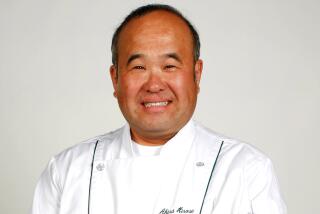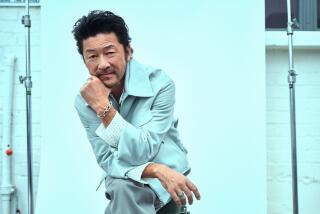Eastern tradition, western influence
- Share via
TOKYO -- As a teenage percussionist growing up in Japan in the 1980s, Shuichi Hidano’s favorite drummers were the guys who sat behind the kit in British rock bands, musicians like Stewart Copeland of the Police and Bill Bruford, who played in those now-deeply unfashionable progressive rock bands King Crimson and Yes. “I loved John Bonham too,” says Hidano of the late Led Zeppelin drummer, an innovator who swelled his heavy backbeat with congas, orchestral timpani and other flourishes.
Hidano produces a big, complicated sound too, but you’re not likely to catch him sitting behind a drum kit. He plays standing up, a muscular 38-year-old pulling thunder out of an array of traditional Japanese taiko drums. First used to send messages between ancient villages, then as instruments of war and intimidation, the long-sustaining sounds of taiko are now played mostly by musical ensembles. Taiko players dart from drum to drum, punctuate their rim shots with shouts, and wail on the skins with sticks the size of pipe bombs.
It is a distinctly Japanese percussion style, though Hidano is doing his best to see how far he can push the music from those roots.
“I studied traditional Japanese rhythms and I’m always aware that I’m a Japanese drummer, but I grew up with western music and I’m drawn to that,” Hidano says, sitting in a Tokyo hotel lounge before leaving for a concert on Saturday at the Japan America Theatre in L.A.’s Little Tokyo.
New ideas needed
His quest has turned him into a musical pilgrim. He travels extensively to play with foreign musicians from the Middle East to Africa -- especially in Zambia where, he says, the Music Gods reside. He knows the days when a musician could entertain a foreign audience just by showing up with an exotic ethnic instrument are over. If taiko is to have a future, he argues, it will have to unlock new musical ideas.
“Taiko has become very much composed, almost like classical music,” Hidano says. “Everybody has to do the same thing or else you get ostracized. You have to worry about raising your sticks to exactly the same height as the other drummers.
“That doesn’t always make for good music.”
So anyone hoping to hear a standard Japanese drumming session at the Japan America Theatre is advised to stay home.
“For Japanese Americans, taiko is a nostalgic sound,” Hidano explains. “When they invite me they expect me to perform in a traditional style. They want a connection to Japan, and there is no way they can stand something completely new.”
So this weekend’s concert is not at anyone’s invitation. It’s his own show, Hidano says, and he’s put together a set of tangos, original ballads and rock songs, with plenty of eastern sounds thrown in for freshness.
Hidano will be accompanied by musicians playing the koto and the shamisen, traditional Japanese stringed instruments, but he’ll also have an electric rock guitarist (Jennifer Batten) as well as Sri Lankan-born L.A. session bass player Hussain Jiffry. The rhythm section will include samba percussionist Chalo Eduardo and versatile L.A. session drummer John “JR” Robinson.
“Hidano is easy to play with because his timing is so good,” Robinson said in a phone interview from Vancouver, Canada. “He wants my kick drum underneath his sound and he’ll swing on top of it, as only he can.”
Not everyone thinks Hidano is onto something. Older taiko fans in Japan see him as a “delinquent,” Hidano admitted.
“Some older people expect to hear the big roaring sound of taiko and they reject his style,” says Akitoshi Asano, chairman of the Asano Foundation for Taiko Culture Research in Japan who describes Hidano as a drummer of “magical ability.” It is young people who tend to enjoy Hidano’s complicated, speedy rhythms and exuberant personality, Asano notes.
But he’s also up against the entrenched grip of Kodo, a group of drummers who live communally on Sado Island off Japan’s west coast and have, since the 1980s, worn the mantle of taiko’s proselytizers in chief. Kodo took taiko from a dowdy accessory at religious festivals to its modern sound, and Kodo has toured Europe and America extensively, where audiences often mistake the post-war development of ensemble drumming for the revival of an ancient art form.
Rock, classical and jazz
Hidano spent a year apprenticing with Kodo but left, he says, out of frustration with the group’s rigid approach to music. He calls Kodo “not quite traditional; not quite creative.” (Kodo members refused to speak for this article.) Instead he turned for inspiration to some of the western influences he loved growing up: not just rock bands but the classical CDs his parents played during his childhood and the jazz he gravitated toward later.
Yet Hidano knows that simply blending musical styles does not guarantee success. “Drumming in any culture is linked to the rhythm of the spoken language,” he says. “Ever hear a Japanese rapper? It doesn’t work.”
But he argues that his ability to jam with drummers from Brazil to Zambia proves it’s possible to pick up languages.
He remains particularly entranced by the way music courses through the Zambian people. He remembers playing under the open sky there one day about 10 years ago and watching an old man approach, carrying his own little drum under one arm.
“He said, ‘Your drum looks very expensive,’ ” Hidano recalls, smiling at the memory. “ ‘But,’ he said, ‘mine has better sound.’ ”
--
--
Naoko Nishiwaki of The Times’ Tokyo bureau contributed to this report.
More to Read
The biggest entertainment stories
Get our big stories about Hollywood, film, television, music, arts, culture and more right in your inbox as soon as they publish.
You may occasionally receive promotional content from the Los Angeles Times.










